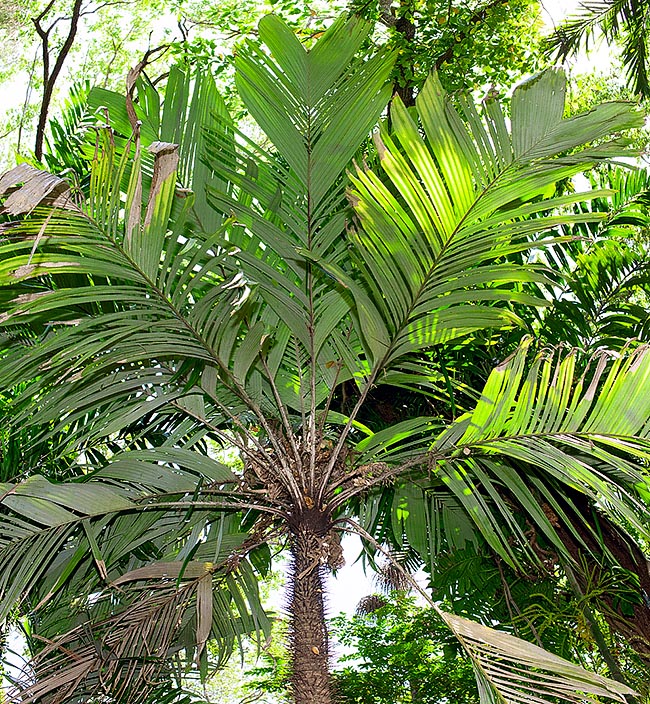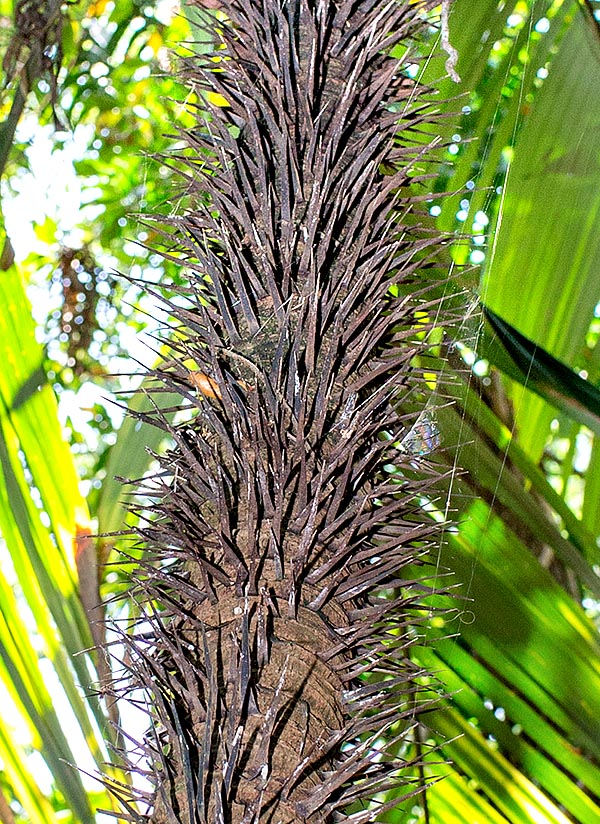Family : Arecaceae

Text © Pietro Puccio

English translation by Mario Beltramini

The Astrocaryum mexicanum can be 6,5 m tall in the low altitude rain forests of Central America © Giuseppe Mazza
The name of the genus is the combination of the Greek substantives “ἀστήρ” (aster) = star and “κάρυον” (karion) = nut, seed, with reference to the marks present on the seed; the name of the species is the Latin adjective “mexicanus, a, um” = of Mexico, with reference to the place of origin of the type species.
Common names: Mexican forest palm (English); lancetillo (Guatemala); lancetilla (Honduras); acté, chapay, chicalito de tuxtepec, chichón, chocho, coyol redondo, palmilla, tzitzún (Mexico).
The Astrocaryum mexicanum Liebm. ex Mart. (1853) is a species with solitary stem, cylindrical, 1,5-6,5 m tall and of 4-7 cm of diameter thickly covered in correspondence to the scars of the foliar bases of rings of flat spines, black, 3-6 cm long, facing various directions.
Apparently simple leaves, or irregularly divided in the young plants, pinnate in the adult ones, up to about 2 m long, with 15-30 pairs of alternate leaflets, linear with acuminate apex, regularly arranged on a same level along the rachis, 40-50 cm long and 2-2,5 cm broad, the terminal ones united, fishtail, with apex truncated and irregularly toothed, dark green above, glaucous below. Petiole, 50-60 cm long, rachis and foliar base, that wraps only partially the stem, are provided of spines of various length and pointing in different directions.

The 4-7 cm broad trunk is protected by showy flat spines. The unripe inflorescences and the endosperm of fruits are edible. Very ornamental species, but to utilize far away from passage sites © Giuseppe Mazza
It propagates by seed, previously cleaned from the pulp and immersed in water for two days, in organic draining loam maintained humid at the temperature of 24-28 °C, with germination times starting from 2-3 months.
Very ornamental palm, but to utilize far from places of passage and of rest due to the dangerous spines on the stem and also due to the fruits that while falling on the soil may represent a danger. The young plants are particularly attractive with the undivided leaves, if positioned in sites sheltered from the wind, and may be kept in pot for the decoration of greenhouses and shaded winter gardens. Cultivable in the tropical and humid subtropical climate regions, its cultivation can be tried in the milder warm temperate ones where temperatures around the 0 °C are very short lasting exceptions. It requires fertile and perfectly draining soils, acidic to neutral, maintained constantly humid, but without stagnations, a shaded position during the first years of growth, then from slight shade to full sun when adult.
The stems are utilized by the local populations in the rural constructions, the leaves as cover, the not mature inflorescences and the endosperm of the fruits as food.
Synponyms: Astrocaryum rostratum Hook.f. (1854); Astrocaryum warscewiczii H. Karst. (1858); Astrocaryum warszewiczii H.Karst. (1858); Astrocaryum chichon Linden (1881); Bactris cohune S.Watson (1886); Astrocaryum cohune (S.Watson) Standl. (1930); Hexopetion mexicanum (Liebm. ex Mart.) Burret (1934).
→ For general notions about ARECACEAE please click here.
